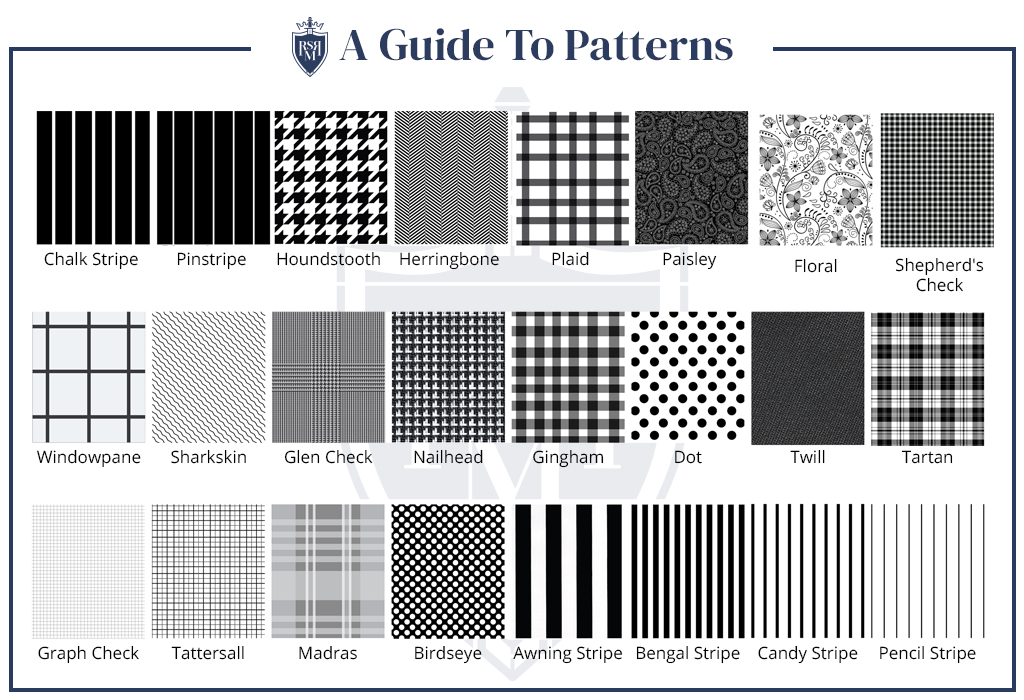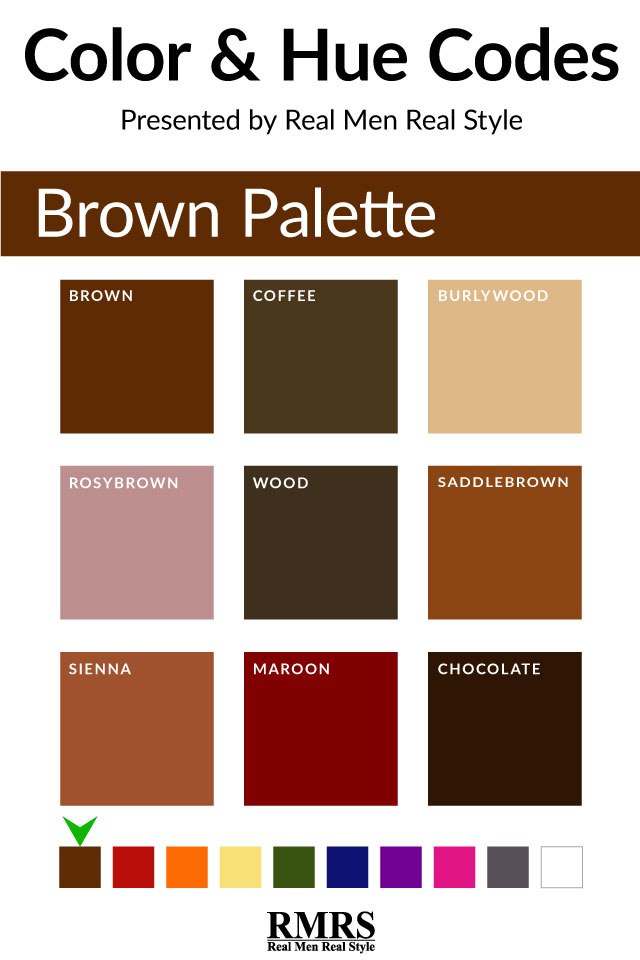There are two types of pattern-heavy outfits:
The one that turns heads…
…because it's impeccable.
And the one that does the same…
…because it's atrocious!
If you can pull off patterned outfits successfully, the return can be big. Among other things, it can up your chances of catching a woman's eye in a crowd of men.
But it requires a bit of courage and a fair amount of know-how.
Fortunately, there are time-honored and simple rules for pairing patterns so they'll look great, and today we're going to be teaching you all of them.
I'm going to tell you the most common types of patterns, and five rules to matching them easily. But let's start out with a quick hack explaining how I put this outfit together.

As you can see, I'm wearing a floral necktie. The hack: when matching difficult patterns, wear an accessory with multiple colors and make everything else in your outfit match at least one of those colors.
The shirt is a dark navy with a small dot pattern (which you might not be able to see in the photo). The necktie has that dark navy as a background. It has a blue that matches the jacket and a pink that matches the pocket square. Why does it all work so well?
The maker of this necktie chose colors that work harmoniously together. I simply rode on his coattails and repeated those colors in the entire outfit. That's a hack you can take to the bank. Check out our guide on how to match colors for more tips.
Let's do a quick review of the most common patterns you'll encounter. Click on the infographic below for a closer look at them.
Types Of Patterns In Menswear
#1. Solids
Solids are not patterns. Solid garments have one plain color with no pattern in it.
#2. Stripes
Chalk stripes and pinstripes are most common in suits. In shirts, you'll often see the awning stripe, the Bengal stripe, candy stripes, and pencil stripes.
#3. Checks
Checks are also quite common in shirts. There's a wide variety of them – tartan, glen check, graph check, gingham, and tattersall, among others. We also see these patterns in suits, neckties and pocket squares. Houndstooth and shepherd's check are popular choices for sports jackets.

#4. Twills
A twill weave is a type of tight weave with the warp over the weft. The most commonly seen twill is the herringbone weave – a distinctive pattern that actually does look like a fish bone. You'll often find it in shirts and sometimes in jackets and trousers. I love twill because it's so versatile. It's so tight that it looks like a solid from a distance.
#5. Birdseye, Nailshead, And Sharkskin
These are small repeating patterns that, again, look like solids from a distance. They offer a pleasant surprise once people get close to you and see the pattern. They're found in casual suits.
#6. Florals
Florals can be bold (with large patterns and bright colors) or subtle (with small repeating patterns and muted colors). Flower motifs have appeared in menswear for thousands of years. In my opinion, they're one of the most underrated patterns a man can bring into his wardrobe. They work great on ties, squares, and shirts. For the latter, keep the pattern small unless you're at a luau.
#7. Paisley
Paisley hails from India and it's very distinctive. Its unique, swirling spirals never fail to grab attention. I think paisleys are beautiful in smaller accessories like pocket squares and neckties.
#8. Dots
Dot patterns range all the way from formal to casual, depending on their size and the amount of contrast with the background fabric. A larger dot with high contrast is very casual. A dot that's small and subtle is more formal.
Now let's get on to those five rules of pattern matching.
Keep Colors Muted
Go with colors that you already love and have in your wardrobe. I'm partial to blues like navy, indigo, cobalt, and admiral blue, plus greens like pine and juniper and browns like chocolate, cinnamon, and gingerbread. Yes, these are all real names of colors that I wear. For accent colors, I like to bring in whites, reds, perhaps a bit of orange.
Stick with colors that you know are going to work for you so you can focus on the pattern.
If you're going to try out a super bold pattern that you've never worn before, don't bring in a color you're not sure about. Otherwise you'll look and feel awkward and won't wear it often.

Bring In Patterns Gradually
Base items like jackets, trousers, and shirts cost a lot more than small accessories like neckwear and pocket squares. So start with patterned accessories. They're items that you can switch out easily. Since they're less expensive, you can afford to experiment and make mistakes with them.
The next place to bring in patterns is in your shirts. A patterned shirt that doesn't work for you is a far cheaper mistake than a patterned suit that you realize, too late, you can only wear once a month.
Patterned items like suits, trousers, and even shirts have to rotate through your wardrobe. You can't wear them again and again. This is why solids should form the basis of your wardrobe.
Once you've got the hang of a patterned shirt and tie – especially if you're wearing professional clothing on a daily basis – you can start to bring in patterns on your jackets for a bit of fun.
But be very careful with patterns on your trousers. Patterned legs moving against each other create the impression that the patterns themselves are moving. It's a bit off-putting to the eye, and not particularly attractive. Besides, you want to avoid drawing too much attention to that area of your body in general.
Avoid Similar Patterns Next To Each Other
This means no patterns of a similar size and type. You don't want two paisleys right next to each other and you don't want to pair a pinstriped suit with a pencil-striped shirt and a pinstriped necktie. It just looks to matchy-matchy, as though you're trying too hard, and it can cause that “moving patterns” optical illusion I mentioned above. Instead, try matching that pinstripe suit with a twill shirt and a dotted necktie.
It's perfectly all right, however, to wear patterns next to each other that are the same type but a DIFFERENT size. For example, you can wear a pinstriped suit with a Bengal stripe shirt – the thickness of the lines is quite different, so it works.
Large patterns on neckties are useful here as well. It's not something I highly recommend (I'd rather you get a bit more creative). But you can pull it off.
Complement Patterns, Don't Match
When two pieces match exactly- same pattern, same color – it looks boring and amateurish. Try to complement your outfit instead.
If you want to level up your style, look for colors that work well with other colors in your outfit. That's why I like colorful accessories: they allow you to choose from many different colors when putting together an outfit.
Even if the patterns are different types, your tie pattern should be at least slightly bigger than your dress shirt pattern to prevent the tie from getting lost. One exception is ties with the versatile pin dot pattern (pictured), which is subtle enough to pair with a range of pattern sizes on either side of the scale.
Practice And Have Fun
Wear patterns to draw positive attention to yourself, to get compliments, to build up your confidence. As with any new skill, this one takes practice. Experiment. Let yourself make mistakes. Learn from them. Accept that you'll put together some outfits that just don't work, and treat them as experimental data. Figure out why they look bad and what you need to fix so they'll look good.
Don't be afraid of pattern matching. With a bit of practice you'll quickly figure out what does and doesn't work.
So few men bring patterns into their style. Stand out from the crowd and level up your style with them.
Bottom line: as long as you mix either the type or size of patterns you're wearing and you're smart about how you layer them, you're certain to build an outfit that signals taste and success. Now go. Attract some attention for the RIGHT reasons – armed with the secrets of perfect pattern matching.
Click Here To Watch The Video – How To Match Different Patterns?
Click Here To Watch The Video – Pattern Mixing For Men
If you're a busy, success-driven guy who wants a concentrated shot of pure style FAST, click here to check out my premium courses.
The post How To Match Different Patterns? | Pattern Mixing For Men appeared first on Real Men Real Style.
0 Commentaires